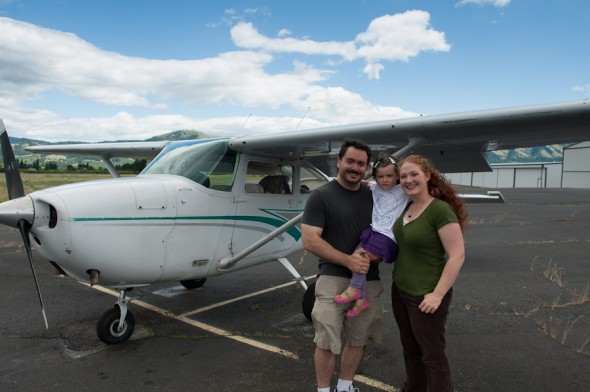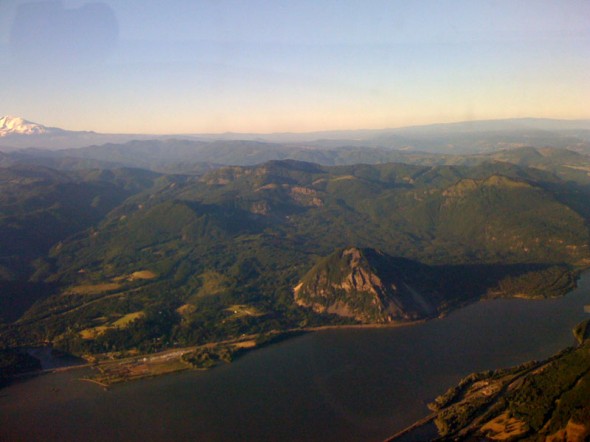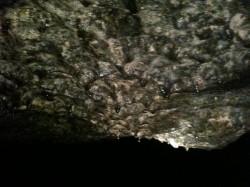I spent a very special Father’s Day with Siena when I took her flying with me for the first time. She had been asking about “flying with Daddy” for some time now, but I was waiting until she was old enough to thoroughly enjoy the entire experience. A few weeks ago we tried to schedule the airplane for a few hours but our plan was shot down when we learned that the airplane had been grounded for weeks due to an FAA paperwork issue. Still, we went to the airport anyway and used the opportunity to check the fit of her car seat and bask in the excited glow of a three-year-old surrounded by airplanes taking off and landing.
Trout Lake Fishing Derby
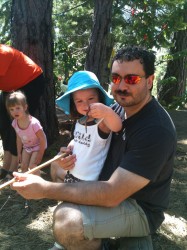 Every year around Father’s Day, the US Forest Service organizes a fishing derby at a park in Trout Lake, WA. The creek that flows through the park is screened off and stocked with rainbow trout, after which the community is invited to catch and cook fish, participate in various kid-centric activities and learn about the forest service and fishing in general. This was an excellent opportunity for a family adventure and our second year attending this event. Unfortunately we were unable to arrive until most of the families had left the event. The forest service had closed their displays and the finger-painting tent and bouncy house had both been taken down. But this didn’t disappoint us since we were there to fish. We arrived at the creek and discovered that most of the fish still remained, along with the make-shift fishing poles constructed out of tree branches. We grabbed a fishing pole, baited our hook and made our first cast. I stood behind my daughter and patiently instructed her on how to strategically cast the line upstream, allowing the current to bring the worm to the fish. She was more focused on asserting her desire to hold the fishing-stick herself since she was a big girl. This continued until we hooked our first fish, but he got away. This cycle repeated a few more times until we landed our first trout. She immediately wanted to pick it up and hold it just before she asked when we were going to eat it. By the end of the day we caught our limit and I cleaned our catch while Siena jumped on our friend’s trampoline. The fish are currently in our freezer and I’m sure they’ll make a delicious dinner Sunday evening.
Every year around Father’s Day, the US Forest Service organizes a fishing derby at a park in Trout Lake, WA. The creek that flows through the park is screened off and stocked with rainbow trout, after which the community is invited to catch and cook fish, participate in various kid-centric activities and learn about the forest service and fishing in general. This was an excellent opportunity for a family adventure and our second year attending this event. Unfortunately we were unable to arrive until most of the families had left the event. The forest service had closed their displays and the finger-painting tent and bouncy house had both been taken down. But this didn’t disappoint us since we were there to fish. We arrived at the creek and discovered that most of the fish still remained, along with the make-shift fishing poles constructed out of tree branches. We grabbed a fishing pole, baited our hook and made our first cast. I stood behind my daughter and patiently instructed her on how to strategically cast the line upstream, allowing the current to bring the worm to the fish. She was more focused on asserting her desire to hold the fishing-stick herself since she was a big girl. This continued until we hooked our first fish, but he got away. This cycle repeated a few more times until we landed our first trout. She immediately wanted to pick it up and hold it just before she asked when we were going to eat it. By the end of the day we caught our limit and I cleaned our catch while Siena jumped on our friend’s trampoline. The fish are currently in our freezer and I’m sure they’ll make a delicious dinner Sunday evening.
Fuss Nugget is my Co-Pilot
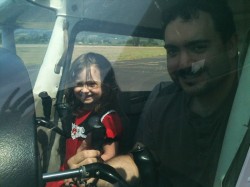 I haven’t yet taken my daughter flying with me and she keeps bugging me about it. My typical response is “when you’re older” which satisfies her for about 5 minutes. I recently thought about it and I’ve come to the conclusion that she is ready go to flying with her daddy. The Memorial Day weekend was a perfect opportunity to fly and the weather could not have been better. However, when I called the airport to schedule the Cessna, I learned that my airplane had been grounded due to a registration error. No flying today! Instead I used this as an opportunity to test my kid and she if she is ready for an airplane ride. The test consisted of the following checklist: [Read more…]
I haven’t yet taken my daughter flying with me and she keeps bugging me about it. My typical response is “when you’re older” which satisfies her for about 5 minutes. I recently thought about it and I’ve come to the conclusion that she is ready go to flying with her daddy. The Memorial Day weekend was a perfect opportunity to fly and the weather could not have been better. However, when I called the airport to schedule the Cessna, I learned that my airplane had been grounded due to a registration error. No flying today! Instead I used this as an opportunity to test my kid and she if she is ready for an airplane ride. The test consisted of the following checklist: [Read more…]
More Fun at the Range – Ice Blocks for Target Practice
We went back to the range this weekend with six ice blocks. Our group had a variety of rifles this time in .308 Winchester, 7.62×51 M118Lr, .30-06 Springfield, 8mm Mauser and .444 Marlin. As appealing as it was, I resisted the urge to just empty an M14 magazine. Perhaps its the engineer in me, but I wanted to test each cartridge on a different block of ice and record the results. Surprisingly, the .30 caliber rounds made more spectacular explosions than the .444 Marlin. While we were dismantling the block ice, my two-year-old was watching with LRH safely from the parking lot. After we started the experiment she commented, “loud things break a snows Momma”. LOL.
She also commented when the guy with the Mauser took three shots to bring down the block. He was using AP rounds so they punched little holes in the ice that she couldn’t see. Her remark was, “he can’t do it Momma, Daddy do it!” Just priceless.
Fun at the Range: Shooting an Ice Block
I had a good time at the range this Saturday. We showed up with a block of ice, placed it at about 25 yards and proceeded to destroy it with one 40-caliber rifle round. I’m going to bring 5 blocks next time I go shooting. Check this out:
The 444 is an intimidating cartridge that produces plenty of recoil. There was a small group of guys at the range and only two of them were willing to shoot that rifle. My wife walks up, chambers 4 rounds and proceeds to dismantle a block of wood at 50 yards. After she was done, her first comment was “that didn’t kick much.” Any woman who can handle a large-bore rifle is hot. Add red hair to the mix and you’ve got mega-hot so I count myself blessed!
We also brought some clays and put them on the hill at 100 yards. We had a Mini-30, Mini-14, 30-30 and a brand new absolutely badass Ruger Sr-556. Those clay zombies didn’t last long. I’m going back in a few weeks with more ice blocks and a real video camera (not that worthless thing in my iPhone). Stay tuned.
Shooting in the Dark: How to do Muzzle Flash Photography
I brought my camera to the range yesterday with the intent to capture some muzzle blasts from pistol rounds. The idea was originally inspired by my friend who has a Bersa Thunder in .45 and some +P rounds. The results were amazing, to say the least.
The process is fairly straightforward provided you have solo access to an indoor range or can find a safe place outside to shoot with low lighting conditions. You’ll need a good SLR camera with support for bulb exposure, a solid tripod and some patience. Follow the tips below:
- Choose a location where you have control of the light. Ideally this would be access to a private indoor range. In order to get a good exposure, the shutter of the camera must be depressed with ambient light at a minimum. Obviously it would be unwise to shoot in complete darkness, so dim the light just enough that you won’t overexpose but are still able to see the target. Always observe the four rules of gun safety, especially rule number 4: “be sure of your target and what lies behind it.”
- Set up the tripod and camera near but slightly behind the shooter. Adjust the focal length to frame the photograph how you want. If you instruct the shooter to keep the firearm in an invisible box, you can try zooming in to fill the frame with more of the blast.
- With the lights on, instruct the shooter to take position and take aim, but not fire. Set the focus to manual and adjust until the firearm is in focus. In cameras that have a live-view mode, this is a simple task since the LCD display can be zoomed in while the focus ring is tweaked appropriately. Mark the position of the shooter’s feet, so he can return to that position for subsequent shots.
- Set the camera to the lowest ISO speed to reduce grain and light sensitivity.
- Set the camera for manual bulb exposure and adjust the aperture to an fstop that darkens the background without reducing the muzzle flash. I found that f/5.6 to f/8 works the best in very dim light.
- With the shooter in position, turn down the lights and instruct the shooter to fire after depressing the shutter button. A bulb exposure holds the shutter open as long as the button is pressed, so when the shooter is done firing the button may be released and the muzzle flash will be captured.
- Adjust aperture as needed to brighten or darken the blast.
Here are the results:
Halloween 2010: Ducks, Airplanes and Baseball
My parents have been visiting for the past week from California, planning to head home in a few days. After our flight to Madras and other plans were derailed by weather, we tried to make the most of this sunny Sunday. We began by taking Siena to a local lake and letting her feed ducks and play in the fallen leaves. She had so much fun here that when it was time to leave she tried every stalling tactic in her book.
It was here that I realized that I could still take my parents flying, so we headed to the airport and spent the next hour viewing the valley from the air. The fall colors were incredibly vibrant and the angled sunlight made them pop like a perfectly exposed postcard. I took my Dad up over Lost Lake at the base of Mt. Hood and later took my Mom around the valley for a quick 20-minute loop. They both had a great time while Siena was safe on the ground walking the flight line and pointing out air traffic. After I landed the second time, I stepped down out of the airplane and Siena came running toward me shouting “Daddy flies airplanes!”.
After dropping my parents off at a local restaurant and bar (so they could watch the World Series), LRH and I took Siena trick-or-treating. She was dressed up as a little dragon this year and she spent the 15-minute entrance wait perfecting her roar. Our little nugget made off with plenty of candy for her second run! Later, we returned to the restaurant and joined my parents just in time to watch the SF Giants completely dismantle the Rangers… again. My Dad is (and always was) a die hard Giants fan and that rubbed off on me. I still cheer for them, which brings to light an interesting contradiction. This is the only time I will cheer for San Francisco against George Bush and Texas! LOL.
Scenic Flight to the Bonneville Dam
Earlier today I took the Cessna up for a solo scenic flight to Cascade Locks and the Bonneville Dam. I departed the airport and almost immediately encountered heavy crosswinds and thermals. The ride was bumpy until I reached my cruising altitude of 6500 feet. After that, it was smooth sailing on a beautiful day with perfect visibility. The sun was low (2 hours from sunset) so all of the valleys and terrain features were nicely lit with deep shadows. Cruising above the timberline while listening to Sabaton and taking in an amazing vista: life is good.
I snapped a few iPhone photos along the way:
Hawk in Winter Earned His Wings
It’s official, I’m a private pilot. Exactly one year from the day of my first flight, I took and passed my checkride. I arrived at the airfield at 8AM and proceeded to endure a seven hour test that I can only describe as brutal. The checkride consisted of an oral exam on the ground covering all areas of aviation knowledge and concluded with a few hours in the air including navigation and demonstrating maneuvers. After the ordeal I was exhausted, but pleased that I completed my goal.
My first passenger was my beautiful wife. For her birthday, we took a scenic flight around the local valleys and she captured some of it on her cell phone camera:
Here are some shots from my solo cross country flight to Madras, one of the requirements I had to complete to earn my private pilot certificate:
Flying is always exciting, especially when a huge forest fire has the next valley over ablaze and a TFR (temporary flight restriction) is placed directly above your home airport.
Exploring the Ape Cave on the Slopes of Mount St. Helens
For my wife’s birthday I took the day off work, arranged child care and gave her a choice between two adventures (both about 2 hours away). Her first option was a hike to Ramona Falls in the Mount Hood National Forest, a 7-mile forest stroll with an impressive waterfall. Her second option was a visit to the Ape Cave in the Gifford Pinchot National Forest near Mount St. Helens. She had been to Ramona Falls many years ago and the Ape Cave seemed more adventurous so her choice was simple.
Formation
The Ape Cave is a lava tube, a type of cave commonly found throughout the Pacific Northwest. Lava tubes result from flows of low-viscosity basaltic lava, called “pahoehoe” flows, which are drastically different than the explosive pyroclastic flow resulting from the Plinian eruption of Mt. Saint Helens in 1980. As the lava is expelled from the volcano, its surface hardens and forms a crust enclosing a conduit of smooth flowing lava. Eventually the conduit drains leaving a hollow tube and step marks on the walls, called flow ledges, denoting the depth of the flow. After the tube forms and drains, the ceiling of the tube may fracture and create rock-piles that cover the floor. This, along with natural erosion, eventually creates sinkholes and skylights allowing access to the tube.
When most people think of caves, they envision limestone caverns created by water slowly acting on soluble limestone over thousands of years. Features such as flowstone, stalactites and columns are common to such caves and they are very non-linear with many unique rooms and chambers connected with crawlspaces. Many have active rivers running through them and hold underground lakes. Lava tubes are completely different. Their formation does not involve water and happens relatively quickly. They tend to be very linear, sloping down (with the lava flow) and retain a mostly uniform tube shape. Their features may include stalactites (called lavacicles), lava columns and even lava balls. The Ape Cave is one of the few known tubes to contain a lava ball, a large circular piece of hardened lava wedged between two flow ledges. Where limestone caves have waterfalls, lava tubes have lava falls that have since hardened, creating an abrupt drop-off to a lower section of the tube. Because they exist near the surface, lava tubes are damp and feature dripping water that moistens the cave walls nourishing a type of fungal and bacterial life called “cave slime”. [Read more…]
